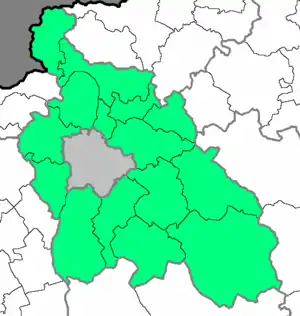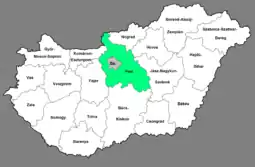Central Hungary
Central Hungary (Hungarian: Közép-Magyarország) is one of the seven statistical regions in Hungary (NUTS 1 and NUTS 2). It includes Budapest (the capital of the region) and Pest County.
Central Hungary
Közép-Magyarország | |
|---|---|
Region | |
 | |
| Country | |
| Capital city | Budapest |
| Area | |
| • Total | 6,919 km2 (2,671 sq mi) |
| Population | |
| • Total | 2,897,317 |
| Time zone | UTC+1 (CET) |
| • Summer (DST) | UTC+2 (CEST) |
| NUTS code | HU1, HU10 |
| HDI (2018) | 0.907[1] very high · 1st |

Administration
Central Hungary's subregions (population figures from the Hungarian Central Statistical Office as of 2009)
Budapest
| Subregion | Seat | Area | Population | Number of settlements |
|---|---|---|---|---|
| Budapest | Budapest | 525.16 km2 (202.77 sq mi) | 1,712,210 | 1 |
Pest County
| Subregion | Seat | Area | Population | Number of settlements |
|---|---|---|---|---|
| Aszód | Aszód | 241.41 km2 (93.21 sq mi) | 35,451 | 9 |
| Budaörs | Budaörs | 240.36 km2 (92.80 sq mi) | 85,115 | 10 |
| Cegléd | Cegléd | 1,234.00 km2 (476.45 sq mi) | 121,149 | 15 |
| Dabas | Dabas | 498.68 km2 (192.54 sq mi) | 44,183 | 10 |
| Dunakeszi | Dunakeszi | 125.17 km2 (48.33 sq mi) | 79,123 | 4 |
| Érd | Érd | 117.95 km2 (45.54 sq mi) | 99,536 | 4 |
| Gödöllő | Gödöllő | 380.88 km2 (147.06 sq mi) | 104,471 | 12 |
| Gyál | Gyál | 286.54 km2 (110.63 sq mi) | 45,944 | 5 |
| Monor | Monor | 449.62 km2 (173.60 sq mi) | 110,287 | 15 |
| Nagykáta | Nagykáta | 711.85 km2 (274.85 sq mi) | 76,909 | 16 |
| Pilisvörösvár | Pilisvörösvár | 245.44 km2 (94.76 sq mi) | 66,702 | 14 |
| Ráckeve | Ráckeve | 628.33 km2 (242.60 sq mi) | 141,756 | 20 |
| Szentendre | Szentendre | 326.58 km2 (126.09 sq mi) | 77,676 | 13 |
| Szob | Szob | 314.73 km2 (121.52 sq mi) | 12,605 | 13 |
| Vác | Vác | 431.81 km2 (166.72 sq mi) | 70,558 | 19 |
| Veresegyház | Veresegyház | 159.79 km2 (61.70 sq mi) | 36,793 | 8 |
Demography
- Total population 2,925,500 (2009)
- 14% aged 0–14 years
- 69% aged 15–64 years
- 17% aged 65 and over [2]
Economy
Central Hungary is the richest and most developed region of the country. The unemployment rate stood at 2.7% in 2017 and was much lower than the national and the european average.[3]
| Year | 2006 | 2007 | 2008 | 2009 | 2010 | 2011 | 2012 | 2013 | 2014 | 2015 | 2016 | 2017 |
|---|---|---|---|---|---|---|---|---|---|---|---|---|
| unemployment rate (in %) |
5.1% | 4.8% | 4.5% | 6.5% | 8.9% | 9.0% | 9.5% | 8.7% | 6.2% | 5.3% | 3.8% | 2.7% |
Tourism
Central Hungary is part of the Budapest Central Transdanubia Tourist Region.
Budapest
In 1987 a World Heritage Site was declared which includes Buda Castle, the Danube Riverbank, the Andrássy Avenue and its historic surroundings, the Millennium Underground Railway and Heroes' Square.
Other important landmarks in Buda are the Gellért Hill and the tomb of Gül Baba and Rudas Baths built during the Ottoman rule of Hungary, ruins of Old Buda, the Coliseum in Nagyszombat Street and the ruins of Aquincum. In the Buda Hills are the Chairlift, the Children's railway and caves with stalagmites and stalactites.
The most important landmarks in Pest are the Hungarian Parliament Building, the St. Stephen's Basilica, the Inner City Parish Church, the Hungarian Academy of Sciences, the Vigadó Concert Hall, the Hungarian National Museum, the New York Palace on the Small Boulevard, the Dohány Street Synagogue, the Grand Boulevard, and the Museum of Applied Arts.
Other important displays are at the Museum of Fine Arts, the Hungarian National Gallery, the Ethnographic Museum, the Budapest History Museum and Statue Park.
Important landmarks are Budapest's oldest bridges, such as the Széchenyi Chain Bridge, the Margaret Bridge, the Liberty Bridge. The biggest parks are very popular, especially the City Park with Vajdahunyad Castle, the Széchenyi thermal bath, the Budapest Zoo and Botanical Garden and the Margaret Island. Budapest is world-famous for its hot spas too.
Budapest holds many perennial events, for example Budapest Fair, Fireworks and Budapest Parade.
Pest County
Places of interest in Pest County are Gödöllő (Royal Castle and Arboretum), Ráckeve (Serbian cathedral and Savoya Castle), Szentendre (Baroque town square, Margit Kovács Museum, Ethnographic Open Air Museum), Vác (cathedral, triumphal arch) and Visegrád (Visegrád Castle).
Other landmarks are the church (built in the Middle Ages) in Zsámbék, the Reformed church of the Holy Roman Empire, the church in Fót in the Romantic style, Apaj plain, ancient juniper fields in Tatárszentgyörgy, equestrianism in Pusztavacs, Attila Rise in Tápiószentmárton, the arboretum in Vácrátót and the bear sanctuary in Veresegyház.
The Pilis Mountains offer plenty of opportunities for hiking. There are also the Visegrád Hills, Ördögmalom waterfall, Gödöllő National Park and Ócsa National Park.
See also
References
- "Sub-national HDI - Area Database - Global Data Lab". hdi.globaldatalab.org. Retrieved 2018-09-13.
- Hungarian Central Statistical Office, 2009.
- "Regional Unemployment by NUTS2 Region". Eurostat.
External links
 Central Hungary travel guide from Wikivoyage
Central Hungary travel guide from Wikivoyage